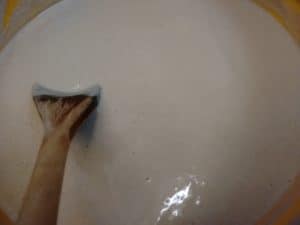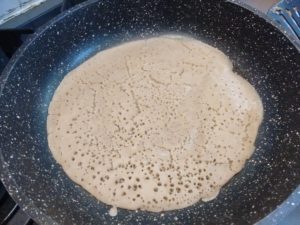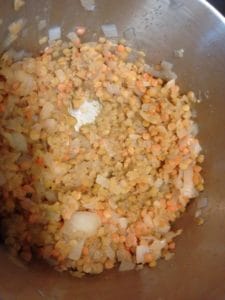Hello, dear readers! I am reviving the website with two Ethiopian recipes that my 20-year-old son tried over the weekend. After the recipes, I’ll share a short review of a few new products from a company called Yoffi.
After high school, my son spent a year volunteering in a town where he interacted with many immigrants from Ethiopia. He’s been wanting to making traditional Ethiopian food, so he consulted with his friends and the internet.
First we have injera, a traditional Ethiopian bread made from the grain teff. He found teff in a store specializing in Ethiopian products, but it is available (at a higher price) in most grocery store chains in Israel.
If you have ever worked with sourdough or any other type of fermentation, injera is a cinch. Even if not, it is fairly simple. “It’s high in protein and calcium, super-nutritious,” my son told me.
The teff sat in our freezer for a few weeks until he came home for long enough to complete the fermenting process. One recipe recommended only one day of fermentation, but most suggest three or four. After 24 hours we decided to let it sit for another 24. I’ve read that fermentation happens more quickly if you do it often, and your kitchen environment is full of wild yeast. This may or may not be true, but 48 hours was more than enough.
Fermentating the teff:
Place a half a kilogram (about a pound) of teff in a large bowl. This amount made six or seven pita-shaped loaves. Keep some extra teff on hand, as you may need it. Add cold water and stir until you get a thick batter. Don’t worry too much about the texture, as you can adjust it later. Cover with a damp cloth or use Marcy Goldman’s trick of wrapping the entire bowl in a clean garbage bag, and tying it. The batter won’t expand much.
Check the mixture the next day. We found a layer of dark, watery liquid on the top (hooch). We kept it, but you can discard it carefully if you like, trying not to spill the thicker part of the batter. Add some warm water and stir, then cover again. You can add more teff if you feel it’s too thin.
Check again the next day (after 48 hours or so). The batter should have a rich, beer-like smell and lots of small bubbles. Here’s how ours looked before cooking.
The batter should be loose and pourable, like a pancake.
Cooking:
Heat up a frying pan. We used a non-stick pan, but if you don’t have one, brush with a little oil. Cover the bottom of the pan with batter. Keeping the heat high, wait until about two-thirds of the pancake has visible bubbles. Then cover the pan for another minute until the pancake is firm. Remove to a plate. The bottom will be crisp. If you’ve ever made crepes, it’s the same idea.
Here’s how it looked when it was done, with the top no longer shiny.
We used the injera to scoop up this simple, spicy lentil stew.
Wot (lentil dip) with chou spice
My son also improvised a wot, or lentil dip, getting the recipe from one of his Ethiopian friends. The defining ingredient, also sold in specialty Ethiopian stores, is a red hot-pepper-based spice mixture. Each store’s mixture is slightly different. I think this must be a version of berbere.
Ingredients:
- 2 teaspoons oil
- 1 onion, chopped
- 3 cloves fresh garlic, chopped
- 1 cup red lentils
- 2 cups water
- 2 tablespoons Ethiopian “chou” spice mix, or berbere
Method:
- Heat oil in pan.
- Sauté onion and garlic in oil until soft.
- Add remaining ingredients and stir. Bring to boil.
- Lower heat, cover, and cook for an additional 20 minutes, until lentils are soft.
- Scoop up with injera. Add fresh chopped vegetables if you like.
We were quite pleased with the result, and definitely plan to make this again. “It’s the kind of food you like,” my son concluded.
Review of Yoffi products
Vad, a representative of Yoffi, an online company selling kosher Israeli products, contacted me to review samples. I asked him to surprise me, so we received chocolate tahini (sesame) spread with hazelnut, sage tea, and silan (date spread). The company takes care to have attractive packaging, especially the red tea tin. My son loved the spread, which lasted about half an hour. We concluded that people who like halva would most enjoy it and if you don’t like halva, don’t bother. It’s rather sweet, but we would buy it again. The sage tea consists of loose, dried sage leaves, and we are enjoying it. We haven’t actually tried the silan yet. While my son likes to cook with it, I don’t, so it is still sitting here. The company is taking Passover gift orders now.
Website: Yoffi.com
I received no compensation for this review.




Great post Hannah, first time I’ve seen this, will be trying it out tonight.